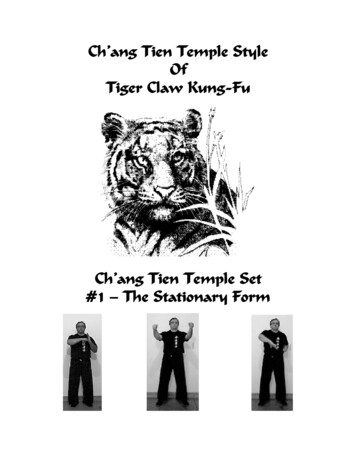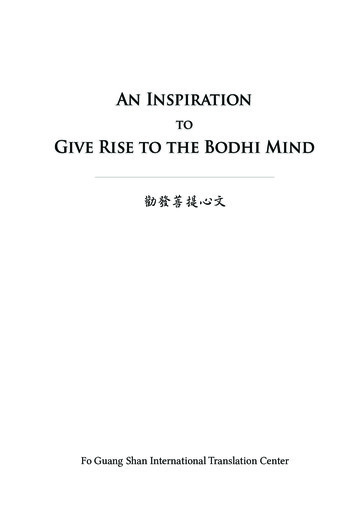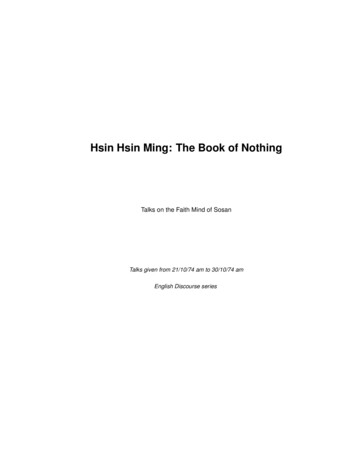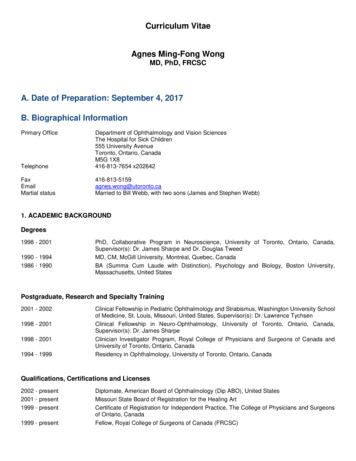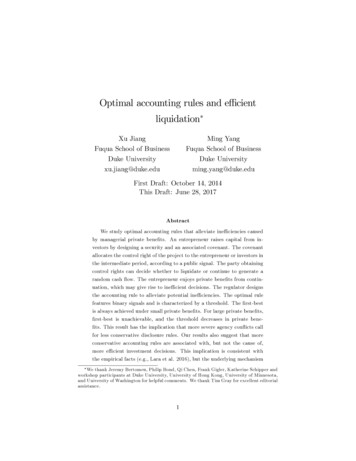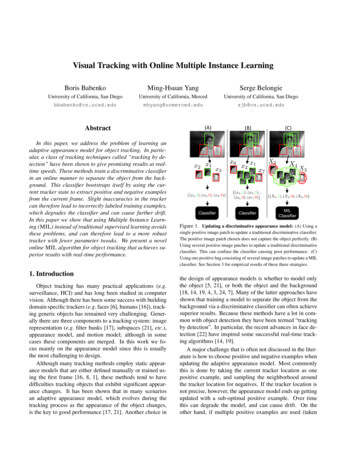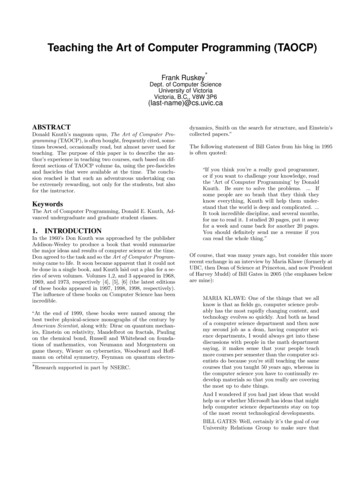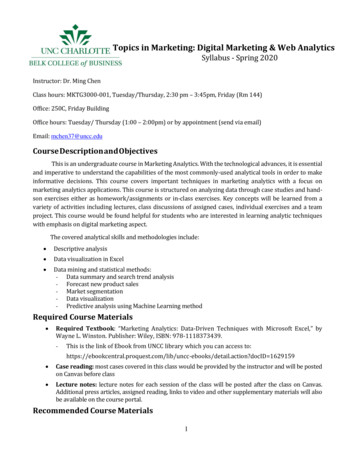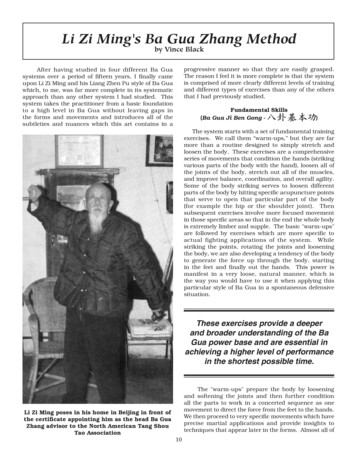
Transcription
Li Zi Ming's Ba Gua Zhang Methodby Vince Blackprogressive manner so that they are easily grasped.The reason I feel it is more complete is that the systemis comprised of more clearly different levels of trainingand different types of exercises than any of the othersthat I had previously studied.After having studied in four different Ba Guasystems over a period of fifteen years, I finally cameupon Li Zi Ming and his Liang Zhen Pu style of Ba Guawhich, to me, was far more complete in its systematicapproach than any other system I had studied. Thissystem takes the practitioner from a basic foundationto a high level in Ba Gua without leaving gaps inthe forms and movements and introduces all of thesubtleties and nuances which this art contains in aFundamental Skills(Ba Gua Ji Ben Gong -)The system starts with a set of fundamental trainingexercises. We call them “warm-ups,” but they are farmore than a routine designed to simply stretch andloosen the body. These exercises are a comprehensiveseries of movements that condition the hands (strikingvarious parts of the body with the hand), loosen all ofthe joints of the body, stretch out all of the muscles,and improve balance, coordination, and overall agility.Some of the body striking serves to loosen differentparts of the body by hitting specific acupuncture pointsthat serve to open that particular part of the body(for example the hip or the shoulder joint). Thensubsequent exercises involve more focused movementin those specific areas so that in the end the whole bodyis extremely limber and supple. The basic "warm-ups"are followed by exercises which are more specific toactual fighting applications of the system. Whilestriking the points, rotating the joints and looseningthe body, we are also developing a tendency of the bodyto generate the force up through the body, startingin the feet and finally out the hands. This power ismanifest in a very loose, natural manner, which isthe way you would have to use it when applying thisparticular style of Ba Gua in a spontaneous defensivesituation.These exercises provide a deeperand broader understanding of the BaGua power base and are essential inachieving a higher level of performancein the shortest possible time.Li Zi Ming poses in his home in Beijing in front ofthe certificate appointing him as the head Ba GuaZhang advisor to the North American Tang ShouTao AssociationThe "warm-ups" prepare the body by looseningand softening the joints and then further conditionall the parts to work in a concerted sequence as onemovement to direct the force from the feet to the hands.We then proceed to very specific movements which haveprecise martial applications and provide insights totechniques that appear later in the forms. Almost all of10
our warm-up exercises have some martial application,however, some are more abstract than others.In going through one full session it is not difficultto see how the practice of these exercises leads to veryrealistic application of the martial technique. All of theslapping and striking of the hands on the body, arms,legs, and on each other, serve to condition the edgesof the hand and the palm because those are the samestriking surfaces we will be using to hit the opponent.So in many of the exercises we strike our own body invarious places to develop the timing and actual strikingsurfaces and thus we tend not to use bags, punchingboards or any of that kind of thing.This system takes the practitioner froma basic foundation to a high level in BaGua without leaving gaps in the formsand movements and introduces all ofthe subtleties and nuances which thisart contains in a progressive manner sothat they are easily grasped.Following the basic loosening exercises, whichinclude striking and kicking, we progress to a seriesof exercise sets, containing three or four complexmovements in each set, which work from a simple toa more complex level of performance. Each set usesthe same line of movement in the body and the sametype of whipping of the body, or coiling of the body, orbracing of the body for a particular kind of strike anddevelopment of a particular type of power. There willusually be three or four exercises in a sequence andthey build one upon the other so that one can see thefoundation and how there is a systematic progressionfrom one technique to the next. It is the same kindof power, or same kind of body movement, whichgenerates the force in each exercise in a given set. Afterseveral of these sets, which include lateral movements,frontal movements, frontal to lateral, and lateral tofrontal types of strategies we later take that kind offlowing connected motion and application of powerinto the forms themselves. These exercises provide adeeper and broader understanding of the Ba Gua powerbase and are essential in achieving a higher level ofperformance in the shortest possible time.Circle Walking Nei Gong(Ding Shi Ba Zhang -Li Zi Ming showing students how the BaGua Zhang sword techniques can be usedagainst a spearbuild leg strength and balance. This leads to thefixed posture walking, or the Ba Gua nei gong ()eight postures (also called Ding Shi Ba Zhang. Theseparticular exercises form a foundation of moving ina circular manner and holding the upper body in afixed posture while the lower body continuously moves.The purpose of holding the upper body is to open thetendon-muscular meridians of the back and the sidesso that the flexibility of the body increases and enablesone to move quickly from one of these postures to thenext as well as to other postures from the “old eightpalms” and Li’s “dragon palms” and other forms in thesystem. The practitioner learns how to change fromone strategy to the next very quickly to adjust to themoves of the opponent.)After refining the warm-up drills and powerdevelopment exercises as described above, we moveon to circle walking exercises. Some of these are justsimple ways of stepping and moving on a circle to11
and then start to combine all of these things on acircular format where the body is beginning to executemore complex martial strategies.Ba Gua Continuous Linking Palm(Ba Gua Lian Huan Zhang -)After working with the “old eight palms” to thepoint where the practitioner is somewhat proficient,we add some other intermediate forms, such as lianhuan (continuously linked) Ba Gua Zhang, which is aparticular series of exercises that combine high and lowattacks, left and right attacks, forward and backwardattacks, moving upward attacks and coming over thetop attacks. We string all of these things togethervery smoothly so that people can use these links,like master links in a chain, to break off from onestrategy and smoothly flow into another. Direction,application, and strategy change according to theopponent's actions. On developing our grappling aspect,of which Li was always enthusiastic to demonstrate,we introduce students to the basic premise of lockand throw with a two person drill known as "chain ofhands," six links or eight links. This exercise developsdirection of stepping, weight shifting, and the finepoints of the locks themselves to build proper responsepatterns for inside fighting.Elbow Training(Ji Ben Zhou Fa -After the lian huan ba gua zhang we then go to formssuch as “thirteen elbows” which offer some training andpossibilities when applying Ba Gua at an elbow strikingrange. This training uses linear as well as circularmovements to achieve a practical understanding of theinside fighting scenario. Training also includes tacticsof moving in to and out of the close range positions.After the student learns how to perform and applythe elbow striking form, we then teach the 64 linearpostures.Vince Black executes a throwing techniquefrom the "Old Eight Palms" form on his studentChris QuayleThe Old Eight Palms(Lao Ba Zhang -))After opening the body and achieving a stablefoundation through the practice of the warm-upexercises and the nei gong palms practice, we go topractice the “old eight palms” form. This form startsto integrate the upper body changes. In the nei gongpalms we hold the upper body static in fixed posturesto "open it up" while developing stability in the lowerbody and power in the waist from the stepping and legmovement. Execution of the “old eight palms” adds theupper body movements which then results in wholebody changes. These eight changes are basic in design,however they have sequences and combinations offighting strategies woven into them that may not beapparent to the casual observer. In the “old eightpalms” practice, the linear movements of the warm-upexercises tie in with the nei gong palms and start tobecome a whole body strategy or whole body techniqueon a circular format. So we first study the straightline movements of the warm-up exercises and thenexecute the circular movements of the nei gong palmsThe 64 Linear PosturesThe 64 postures of the linear system came to usthrough Guo Gu Min, who was one of Li Zi Ming’ssenior brothers in Liang Zhen Pu’s Ba Gua. Theseattacks are very specific in strategy within the detailsof the hand positions, locks, throws, breaks, andpoint attacks. These attacks are sequenced in logicalpatterns of progression that predict an opponent’smove if he were able to escape the first move. In otherwords, each move of the sequence is a counter to anopponent’s escape from the previous move. We learnto stay on the opponent in a very aggressive manner sothat we never give the opponent a chance or an openingafter we initiate our first attack. The 64 postures are1212
in sequences of this manner. They can be practicedagainst each other and recombined in other similartwo-person practice.The Dragon Palm(Ba Gua Long Xing Zhang -or our holding someone else, and we begin to developa "feel" for the limits of our own movement, stability,and balance in terms of our body’s relationship withour foot position and the position of the opponent. Itgives us insight into how to consolidate our whole bodymovement in regards to our footwork.Our sword work for the large double edged swordis similar in design. The movements related to thesword are much more “inside” as they work close toyour own body and entail more intricate twisting andturning. This set also develops more of a counteringnature. In other words, this sword set developsthe strengths and strategies of breaking free of anopponent who has grabbed you. When they seize you,you can learn to walk out of their movements andget in a position for counterattack. The sequenceof the form dictates that you be conscious ofcorrectly moving clear of the opponent’s abilityto continuously lock you as you evade.Itdevelops a kind of movement that requires)Following the sequence of the 64 postures, we thengo to the complex and comprehensive forms such asLi Zi Ming’s dragon palm. The dragon palm combineselements of all of the other forms onto the circularformat. It is a quite extensive form which combinesthe greater percentage of the whole system into onecomplete format. While this form has a quality all ofits own, it also takes everything back to the flavor firstexperienced in the warm-up exercises.We also have numerous two-person practice setsin Li Zi Ming Ba Gua that one will practice to varyingdegrees of intensity depending on your skill and yourpartner’s skill and amount of time you’ve workedtogether. We begin by walking very casually throughmovements in a soft style manner where we movethrough different types of locks and positioningourselves for different kinds of throws. It is kind oflike a Ba Gua push hands exercise, but it is morethan push hands because it is more free form. Thereis not a limited list of locks, throws, or techniques.This exercise is without limit as to what you can bepracticing. It gives one insights into how to developsubtlety and hide your intention as you set people upfor different kinds of tactics.Ba Gua WeaponsIn addition to the solo forms and two-personexercises, we also have weapons sets such as the largeBa Gua broadsword and the large Ba Gua straightsword. While there are very applicable straight swordand broadsword fighting maneuvers one will learnin the execution of these forms, training with theseheavy weapons also conditions strengths and strategiesapplicable to unarmed combat. We use these weaponsto provide something like a resistance training orweight training type of method to develop greaterstrength and more proper connection as we movethrough the postures.When compared to the large straight swordmovements, the movements of the large broadswordare typically executed with the weapon extendedfarther away from the body. By having the extendedweight outside our own body’s reach and having toaccommodate that resistance, the grip of the hand getsvery strong and the shoulder connection develops. Buteven beyond that, practice with this weapon gives us amore finite way of focusing on precise foot movements.When we are moving through a form and we have thekind of resistance that this weapon provides, it cansimulate someone having a hold on our wrist or arm,Li Zi Ming Ba Gua practitioner Chris Quayle workswith the large Ba Gua Broadsword13
Li Zi Ming Style Ba Gua Speciatly WeaponsThe Rooster KnivesThe Chicken Claw KnivesThe Rooster Knives and the Chicken Claw Knives are two of the spcialty weapons used in Li Zi Ming's Ba Gua.Each system of Ba Gua Zhang has small double knives of this nature, the most popular being the cresent moonswords and the deer horn knives. Small doule knives with many cutting edges facing in numberous directions areeffectively employed in combination with Ba Gua's tight circling and turning motions.you to be mindful of where your body is in relationto the blade because you have to walk in and aroundthe blade as you move throughout the form. Since youalso are required to control this heavy blade in a precisemanner during execution of the form, the form developsyour wrist strength to a great degree.There are many more exotic weapons in Li style BaGua both long and short, double and single. However,the most distinctive and practical are the double kniveswe refer to as the "rooster knives" and an adaptationof them called the "chicken claw knives." The roosterknives have an interesting history. These knives werebasically unknown until someone plundered Dong HaiChuan's tomb around 1910 and his original kniveswere stolen and sold in a pawn shop at the antique alleyin Beijing. At that time, no one publicly recognizedthe weapon or knew how to use them. Later, a mannamed Chang Jie Miao () identified the weaponsand while he couldn't use them himself, he broughtthem to public notice by writing about them in his bookYong Zheng Jian Xia Tu (), a book about aQing dynasty sword hero. While he didn't mentionDong's name, he referred to his weapon as the Zi MuJi Zhao Yuan Yang Yue (), or "Mother andSon Rooster Claw Paired Axe." Liang Zhen Pu referedto this weapon as a Rooster Claw Yin Yang Blade (- Ji Zhao Yin Yang Rui). The rooster knifewas a favorite of Liang Zhen Pu and both he and hisstudent Guo Gu Min had their own variations of thisweapon (Guo Gu Min's was the "chicken claw knives")which apply the same basic 24 moves as they wereenumerated by Dong Hai Chuan and integrate them in14
various sequences in the advanced forms.The rooster knives were developed for fightingand visually one can see that they are very dangerousweapons to wield. They have little spots that wereintended to be dipped in poison, they have hooks todraw people in, and numerous cutting edges. Beyondtheir practicality as fighting weapons, both the roosterknives and the chicken claw knives also train variousstrengths that are utilized in unarmed combat.The rooster knives were developed forfighting and visually one can see thatthey are very dangerous weapons towield.The rooster knife is held much like a tonfa, runningup the forearm and behind the elbow, and it has manycutting edges, catching edges, hooks, and spear tipsthat obviously make it a very good inside fightingweapon, but for training purposes it works the tricepsand forces you, because of all the sharp edges, toget your arm rotations very correct when you movethrough your form. The heavy weight of the weaponitself develops strength in the pronating a supinatingaspect of the forearms. The grip of the wrist andthe fingers and the flipping action executed with theweapon for stabbing with the rear end of it also worksthe wrist in a back and forth manner and developspunching power because you are extending and flippingaround seven or eight pounds of weight. It works todevelop the characteristic upward cutting motion ofthe upper arm and shoulder that is so prevalent in theLiang Zhen Pu style of Ba Gua. You see it when goingupward from the bottom and circling over the top andcutting down. It is the action of the triceps and theshoulder rotation together that create this kind ofpower. The rooster knife, being very heavy, helps youto synchronize all of those joints and then the factthat there are many cutting edges, stabbing edges, andhooks in the weapon itself forces you to be very precisein your footwork and body work, especially since youare wielding two of these weapons at the same time.If you only pay attention to one of these weapons atonce it would be very easy for you to hook yourselfwith the other.The chicken claw knives, which were Guo Gu Min’sfavorite weapon, are held more like a regular shortknife with a handguard and a small blade hook to catchthe opponent’s weapon. You also have a tomahawklike head at the end of the sword blade that extends16 to 18 inches. You have three tips out at the endof the sword so that you can hook, grip, or deflect theopponent’s weapon. The are lots of hooking and stabbingactions. This knife works a lot of circular actions with thewrist and thus develops the wrist more than the roosterSome of the Qing Dynasty Era weapons inLi Zi Ming's weapons collection are shown above15
in “iron palm” training can be developed naturally inthe regular training process. A strong resilient bodyand powerful palm strike can be achieved simplyby executing your internal boxing properly. Li gaveme his “iron palm” herbal formula and his trainingmethod, letting me copy his personal notebook as hehad copied it from his teacher before him, so thatI could teach students who needed such training.However, like Li Zi Ming and my other teachers, Ido not emphasize this method because that kind oftraining is not necessary in internal boxing.Li Zi Ming also thought that practicing the Ba Guasystem itself was sufficient to developing skills thatsupplemental qi gong () practice might develop,however, when we discussed qi gong he did offerseveral different types of seated and standing qi gongthat one might practice. He and his wife practiced afew simple qi gong exercises. He did not feel that it wasimportant to have lots of different qi gong exercisesbut rather to practice consistently was absolutelycrucial. He advised to do qi gong in the morning and towash the mouth with salty water prior to commencingthe exercise.Vince Black teaches Li Zi Ming style Ba Gua Zhangat his school in Tucson, Arizona and in seminars atvarious locations throughout the country. For moreinformation about his Ba Gua Zhang program see thelisting on the back page of this issue for his addressand phone number.Vince Black poses with the Chicken Claw Knivesknives, which work more of the triceps muscle andelbow joint.Each of the weapons, while they have very excellentfighting applications, are not that practical in the 20thcentury in America and in a civilized society, however,they still serve to develop strengths and movementsthat are characteristic in our style of Ba Gua. Whilewe also have various other fighting weapons in theLi system, I feel that those mentioned above are theimportant training weapons.Supplementary TrainingIn addition to the above mentioned training methods,Li Zi Ming also had some special supplementarytraining that was given to students on a individualbasis. For instance, Li had an “iron palm” method,however, he did not teach it to many people. This is notbecause it was secret or because it was only reservedfor his top students. It was because Li did not stronglyadvocate this practice and therefore only taught itto those he felt needed it to overcome some trainingbarrier. Li felt, as did many of my other teachers,that “iron palm” was not a necessary practice for theinternal martial artist. The abilities that one attains16Vince Black poses with the Rooster Knives
exercises and the nei gong palms practice, we go to practice the “old eight palms” form. This form starts to integrate the upper body changes. In the nei gong palms we hold the upper body static in fixed postures to "open it up" while developing stability in the lower body a
